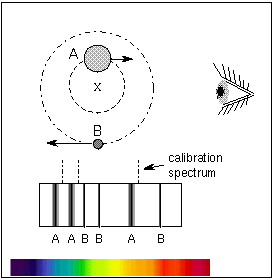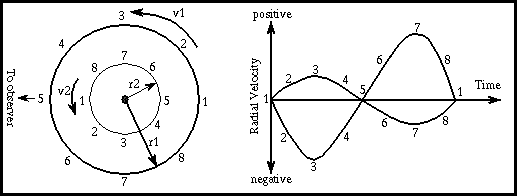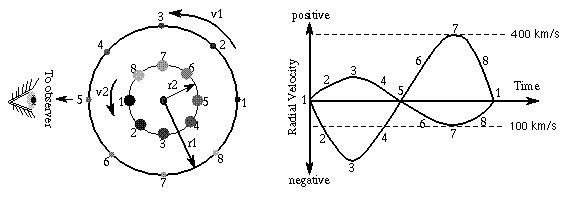
To determine the masses of stars, Kepler's third law is applied to the motions of binary stars---two stars orbiting a common point. The greater the combined mass of the two stars, the greater the gravity acceleration is, and, therefore, the smaller their orbital period. A majority of the several hundred billion stars in the Galaxy are in a system with two or more stars orbiting each other. Usually the binary stars are spectroscopic binary stars. A spectroscopic binary system is two stars orbiting a common point at too great a distance away from us to resolve the two stars individually, but whose binary nature is indicated in the periodic shift of their spectral lines as they orbit around each other. Spectroscopic binary stars are used because (a) there are a lot more far away stars than nearby ones and (b) more importantly, you can easily measure their speeds from the doppler shifted lines.

Newton's form of Kepler's third law gives the combined mass of the two stars: (mass 1 + mass 2) = (separation distance)3/(orbital period)2 if you use solar mass units, the A.U. for the distance unit between the stars, and the time unit of years for the orbital period. The total distance between the two stars is used in Kepler's third law, but their individual distances from the common point they orbit is used to determine the stars' individual masses.

Since stars have about the same mass (within a factor of 20), they both orbit around a common point, called the center of mass, that is significantly different from one of the star's center. The center of mass (C.M.) is the point where (mass star 1) × (C.M. distance 1) = (mass star 2) × (C.M. distance 2), or the point they would be balanced upon if the stars were on a stellar seesaw (it is the ``x'' in the figure below). The massive star is proportionally closer to the center of mass than the low-mass star and the massive star also moves proportionally slower than the low-mass star so its spectral lines have a smaller doppler shift.

Newton's Law of Gravity with Newton's second law of motion explains why this is. Both stars are experiencing the same gravity force between them [since (mass star 1) x (mass star 2) = (mass star 2) x (mass star 1)]. Given the same gravity force at work between the two stars, the lower-mass star will experience a greater acceleration than the more massive star (which star would be like Andre the Giant and which would be like Tom Thumb?). The lower-mass star moves faster and has a larger orbit. The more massive star's orbital speed is less and its orbit is smaller so that the two stars always stay on opposite sides of the center of mass. The two stars inside the binary system have the same orbital period around the center of mass.
Note of caution about comparisons: When comparing two separate binary systemS of the same separation distance, the two stars in the binary system that has larger combined mass will move faster than the two stars in the binary system with less combined mass. The larger combined mass binary has greater gravity force acting between the two stars. When comparing the two stars within a particular binary system, the larger mass star will move slower than the less massive star. The gravity force acting on the two stars within the binary is the same for both of the stars.
The distance travelled by an object = velocity × the time it takes. The distance travelled by the star is just the circumference of the orbit = 2p × the radius of a circular orbit and something similar for an elliptical orbit. Therefore, each star's C.M.-distance r = the star's velocity × the star's orbital period / (2p). This allows you to use the easily measured velocity in Kepler's third law and in the center of mass relations. The doppler shifts of the spectral lines are used to construct a radial velocity curve---a plot of the radial velocity (line of sight velocity) vs. time. The low-mass star will move proportionally faster than the massive star. Note that the two stars will have the same orbital period but the less massive star will have a larger orbit around the center of mass point, so it will have to move faster to compensate---both stars remain directly opposite each other as they orbit the center of mass with the center of mass always in between them.
Uncertainty arises, though, if the binary orbital plane is inclined to our line of sight by an angle amount i. In that very common case, the radial velocity = total velocity × Sin(inclination angle). The orbit's inclination angle i ranges from i=0° for a face-on orbit (viewing the orbit from directly above the system) to i=90° for an edge-on orbit (viewing the orbit along its plane). The inclination angle can be approximately determined from the plot of radial velocity vs. time. If the binary is an eclipsing binary, then you know that i=90° because you see them periodically pass in front of each other. Eclipsing binaries also allow us to accurately determine the diameters of stars (discussed in the next section). The radial velocity measurement technique has also been used to find planets around other stars and to locate black holes from the doppler shifts they produce in the visible stars they orbit around.

Remember these rules:
Using the distance of the center of mass from each star, you can proportion out the total mass to each star. Here are the steps to figure out each star's mass:
(By the way, you can use this proportion idea in cooking if you need to have a 32-ounce mixture and the recipe calls for 3 parts sugar to 2 parts flour or if a recipe is for 6 people but you need to serve 8 people.) The masses of different types of stars are summarized in the Main Sequence Star Properties table below.
Use the UNL Astronomy Education program's Eclipsing Binary Simulator to further explore how the orbits of the stars in a binary star system change with different proportions of the masses (link will appear in a new window). "Eclipsing binaries" are discussed further in the next section of Astronomy Notes.
Even the smallest star's mass is much, much greater than a planet's so a "kilogram" is too tiny a unit of mass to use for the stars. Star masses are specified in units of solar mass---relative to the Sun (so the Sun has one solar mass of material). One solar mass is about 2 × 1030 kilograms.
How do you do that?Use the observed velocities in the figure below to find the individual masses of the stars. The stars have a measured period of 4/3 years and a separation distance of 4 A.U.
 |
One final caution: There is a difference between the mass of a star and its size (diameter)! Just because something is large in size (diameter) does not necessarily mean that it is more massive. Some stars are very large in diameter but have less mass than much smaller stars. For example, in the future, our Sun will become a red giant about 100 times larger in diameter than it is now, but it will have less mass than it does now. It will eventually become a white dwarf about the diameter of the Earth and that tiny white dwarf will be more massive than the much larger diameter ordinary "red dwarf M stars" discussed in a later section.
| center of mass | radial velocity curve | spectroscopic binary |
|---|---|---|
| solar mass |
![]() Go back to previous section --
Go back to previous section --
![]() Go to next section
Go to next section
last updated: June 18, 2022